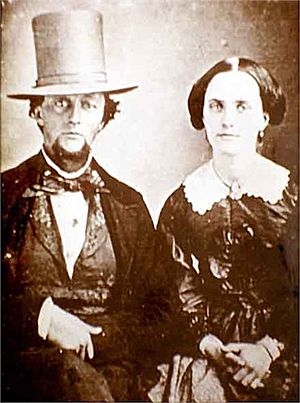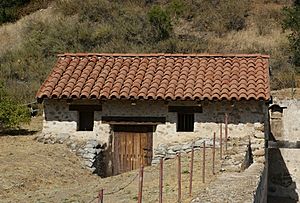Joseph John Chapman facts for kids
Quick facts for kids
Joseph John Chapman
|
|
|---|---|

Joseph John Chapman and Guadalupe Ortega y Sánchez c.1847
|
|
| Born |
Joseph John Chapman
1784 |
| Died | 1849 |
| Nationality | American |
| Occupation | Merchant sailor |
Joseph John "Jose Juan" Chapman (1784–1849) was an American sailor who became one of the first English-speaking settlers in what was then Mexican Alta California. He was also a builder and played an important role in several early settlements in southern California. Chapman was one of the first American-born people to live permanently in Alta California. Even though some details of his life are unclear, he was a valued member of these communities. He also met many important historical figures of his time.
Contents
Early Life and Adventures at Sea
Joseph John Chapman was born in Boston, Massachusetts in 1784. He learned skills like carpentry, blacksmithing, and shipbuilding. As a young man, he started working on ships. When Argentina declared its independence from Spain in 1811, Chapman sailed to South America.
He ended up joining the crew of a ship led by an Argentine privateer named Hippolyte Bouchard. A privateer was like a pirate, but they had permission from a government to attack enemy ships.
There are different stories about how Chapman joined Bouchard's crew. One story says he was forced to join while his ship was in Hawaii. Another says he was part of a crew that tried to sell their ship in Hawaii. Bouchard later got his ship back and Chapman with it. Recent documents suggest Chapman joined Bouchard's crew on his own.
Chapman was with Bouchard's crew during their attack on Monterey, California in 1818. Again, stories differ about how he was captured. Some say he was taken prisoner after a fight between ships. Others say he was captured by Spanish soldiers on shore. One story even says he was captured, freed, and then captured again! Another version says he ran away from Bouchard and surrendered at a mission.
Starting a New Life in California
The first official record of Chapman in California is from 1821. He helped design and build a fulling mill near Mission Santa Inés. A fulling mill was a place where wool was cleaned and thickened to make cloth. During this time, he was told that he was free, as the King of Spain had pardoned American prisoners. He was officially a prisoner until Mexico became independent from Spain in 1821.
In 1822, Chapman became a Roman Catholic at Mission Basilica San Buenaventura. He then married Maria de Guadalupe Ortega, a local girl from a well-known family, at Mission Santa Inés. From then on, he was known as José Juan Chapman. People also called him "Blonde Joe" or "El Diablo" (The Devil).
That same year, Chapman helped finish the roof of the Old Plaza Church in Los Angeles. He led a team into the San Gabriel Mountains to cut down large pine trees for the ceiling beams.
By 1824, Chapman was doing well. He bought a house and some farmland in the Los Angeles pueblo, where he planted a vineyard. He continued to work on projects for the pueblo and for Mission San Gabriel Arcángel.
In 1827, Chapman was one of the few people who spoke English in the area. He was asked to meet Jedediah Smith, another American who had just traveled to California by land. Chapman told Smith about the natural asphalt pools nearby, which were known as La Brea.
Between 1827 and 1831, Chapman designed and built a 60-ton ship called the Guadalupe. He named it after his wife. In 1831, he used his medical skills to help the governor, Manuel Victoria, who was badly wounded in a battle. Chapman dressed his wounds, and the governor survived. That same year, Chapman officially became a Mexican citizen.
Moving to Santa Barbara
After 1831, Chapman and his family moved to Santa Barbara. He bought land near the beach. In 1840, he sold this land and bought other property. Some sources say it was in Santa Barbara County, California, while others say it was near the Santa Clara River in what is now Ventura County, California.
Death and Lasting Impact
Joseph John Chapman passed away on January 10, 1849. He was buried in the Mission Santa Barbara cemetery. He and his wife, Guadalupe, had eleven children. Many of their descendants still live in southern California today.
Images for kids




